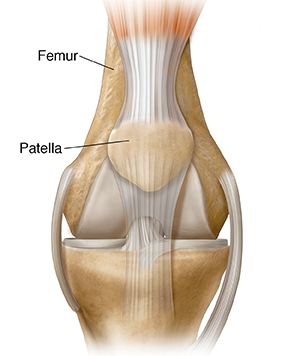Patellofemoral pain syndrome is a condition that causes pain on the front of the knee. The large bones of the upper and lower leg meet at the knee. This joint also includes a small triangle-shaped bone that rests on top of the leg bones. This is the kneecap (patella). Patellofemoral refers to the patella and the thighbone (femur). These bones are surrounded by connective tissue and muscles. Patellofemoral pain is believed to come from stress on the tissues of and around the knee. It's sometimes called runner's knee or jumper's knee because it's common in people who take part in sports.
What causes patellofemoral pain syndrome?
No single cause for patellofemoral pain has been found. But many things are likely to contribute to this type of knee pain. These include:
-
Actions that put repeated stress on the knee, such as running and squatting.
-
Overtraining at a sport.
-
Weak hip or thigh muscles.
-
Variations in the way body parts fit together.
-
Malalignment caused by things like tight muscles, unequal leg lengths, and flat feet.
-
Poor form during activities that stress the knee, such as running.
-
A high BMI (body mass index).
-
A fall or blow to the knee.
Symptoms of patellofemoral pain syndrome
Pain is a common symptom. It’s often on the front of the knee, but can be around the kneecap. Pain can occur at certain times, such as when you are:
-
Running.
-
Jumping.
-
Sitting for a long time with your knees bent, such as at a movie.
-
Walking up or down stairs.
-
Squatting.
Other symptoms may include:
-
A feeling of the knee catching or locking.
-
A grinding or crackling noise in your knee.
Treatment for patellofemoral pain syndrome
Treatment focuses on reducing pain and preventing further injury. Treatments may include:
-
Resting your leg. This gives your knee time to recover. You may need to prevent or change the activity that caused the problem, such as not running for a while.
-
Prescription or over-the-counter medicines. These help reduce inflammation, swelling, and pain. NSAIDs (nonsteroidal anti-inflammatory drugs) are the most common medicines used. Medicines may be prescribed or bought over the counter. They may be given as pills. Or they may be put on the skin as a gel, cream, or patch.
-
Cold packs. These help reduce pain.
-
Stretches and other exercises. These can improve balance, flexibility, and strength.
-
A shoe insert (orthotic). This can make your knee more stable.
-
Elastic tape or a brace. These can make your knee more stable.
-
Physical therapy. This may include exercises or other treatments.
-
Surgery. In rare cases, if other treatments don’t relieve symptoms, you may need surgery.
Possible complications of patellofemoral pain syndrome
If you don’t give your knee time to heal, symptoms may return or get worse. Follow your health care provider’s instructions on resting and treating your knee.
When to contact your doctor
Contact your health care provider right away if you have:
-
A fever of 100.4°F (38°C) or higher, or as directed by your provider.
-
Chills.
-
Pain that gets worse.
-
Symptoms that don’t get better, or get worse.
-
New symptoms.
Author: Freed, Becca
© 2000-2025 The StayWell Company, LLC. All rights reserved. This information is not intended as a substitute for professional medical care. Always follow your healthcare professional's instructions.

